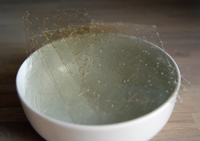
Photo from wikipedia
Abstract The development of new materials with smart properties is currently expanding the development of new technologies. Therefore, the design of materials with novel sensitivities and smart behavior is important… Click to show full abstract
Abstract The development of new materials with smart properties is currently expanding the development of new technologies. Therefore, the design of materials with novel sensitivities and smart behavior is important for the development of smart systems with automated responsivity. We have recently reported the synthesis of hydrogels, cross-linked by N,N'-diallyltartardiamide (DAT). The covalent DAT-crosslinking points have vicinal diols which can be easily cleaved with periodate, generating changes in the hydrogel properties, as well as generating valuable α-oxo-aldehyde functional groups useful for further chemical modification. Based on those findings, we envisioned that a self-healable hydrogel could be obtained by incorporation of primary amino functional groups, from 2-aminoethyl methacrylate hydrochloride (AEMA), coexisting with DAT into the same network. Herein, α-oxo-aldehyde groups generated after the reaction with periodate would arise in the immediate environment of amine groups to form imine cross-links. For this purpose, DAT-crosslinked hydrogels were synthesized and carefully characterized. The cleavage of DAT-crosslinks with periodate promoted changes in the mechanical and swelling properties of the materials. As expected, a self-healing behavior was observed, based on the spontaneous formation of imine covalent bonds. In addition, we surprisingly found a combination of fast vicinal diols cleavage and a low speed self-crosslinking reaction by imine formation. Consequently, it was found a time-window in which a periodate-treated polymer was obtained in a transient liquid state, which can be exploited to choose the final shape of the material, before automated gelling. The singular properties attained on these hydrogels could be useful for developing sensors, actuators, among other smart systems.
Journal Title: European Polymer Journal
Year Published: 2020
Link to full text (if available)
Share on Social Media: Sign Up to like & get
recommendations!